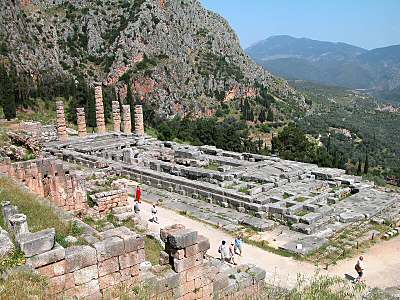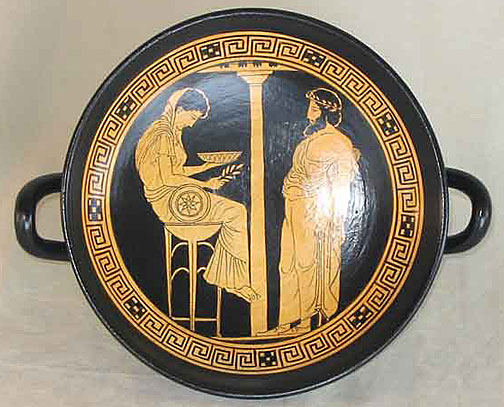The ancient site of Delphi, known for its rich archaeological history and the Delphic oracle was an important panhellenic sanctuary for the worship of the god Apollo. The site was first excavated from 1892-1894 by the French Archaeological School.
The site was also known for the Pythian Games that would take place there. It is believed that athletes would come from all over Greece to compete in the games every four years. Some scholars refute this theory. They believe the topography of Delphi (a hilly and mountainous area) made it unlikely that the games were held within the temenos of Apollo. The steepness of the slopes suggests that the athletic activities were held somewhere else (Whitley, 307). Archaeological excavations have concluded that new stoas (covered walkways or porticos) were built within the temenos during the fifth century, particularly the portico of the Athenians. Also see the Sanctuary of Athena Pronaia.
Delphi remained an extremely important site of worship and athletic events of Classical Greece, however, few architectural alterations occurred.

Overhead shot of the ancient site of Delphi today
The Siphnian Treasury at Delphi, constructed around (530 BCE) is an extremely important building, especially its lavish sculptural decoration that has been preserved. The scenes depicted on the pediment, are not only important for their aesthetic appeal, but also mythological signifigance. The scenes show the epic battle that occurred between Herakles and Apollo for the Delphic tripod. It has been theorized that at least fifteen treasuries were built at Delphi between 600-480 BCE.
In Greek society, an oracle was a person (usually a woman) who was represented as a spiritual counsel or prophet. Throughout time, the Delphic-oracle was regarded as the most renowned oracle in ancient times. It is believed that the oracle was usually an older woman who assumed the role of the Pythia. She resided in an underground chamber (located under the santuary) in which she sat on a tripod seat that was exposed to the earth. She assumed prominence and great influence in the ancient Greek world. Literary evidence suggests that she was consulted before all major undertakings, including: wars, the founding of colonies, etc.
Scientific evidence has also suggested that the Pythia’s prophecies were generated from vapors produced from volcanic faults of the area. This type of exposure to narcotic gases could have possibly induced a trance-like state or a disembodied euphoria. It has been theorized that the physical affects were exhausting.

Red Figure depiction of the Delphic oracle casting a prophecy
Sources:
Biers, William R. The Archaeology of Greece. New York. Cornell University Press, 1980.
Whitley, James. The Archeology of Ancient Greece. United Kingdom: Cambridge University Press, 2001.
Video: http://www.youtube.com/watch?v=vYHIKDMgWI8&feature=related (panoramic view of the site)
Carissa Racca
Posted at Dec 16/2007 11:07AM:
Rachel Griffith: It seems amazing that so many important decisions in the ancient world were depended on the recommendations of one woman! It also is very impressive that there were strong enough inter-polis ties to create panhellenic sanctuaries like Delphi, considering the size of ancient Greece.
